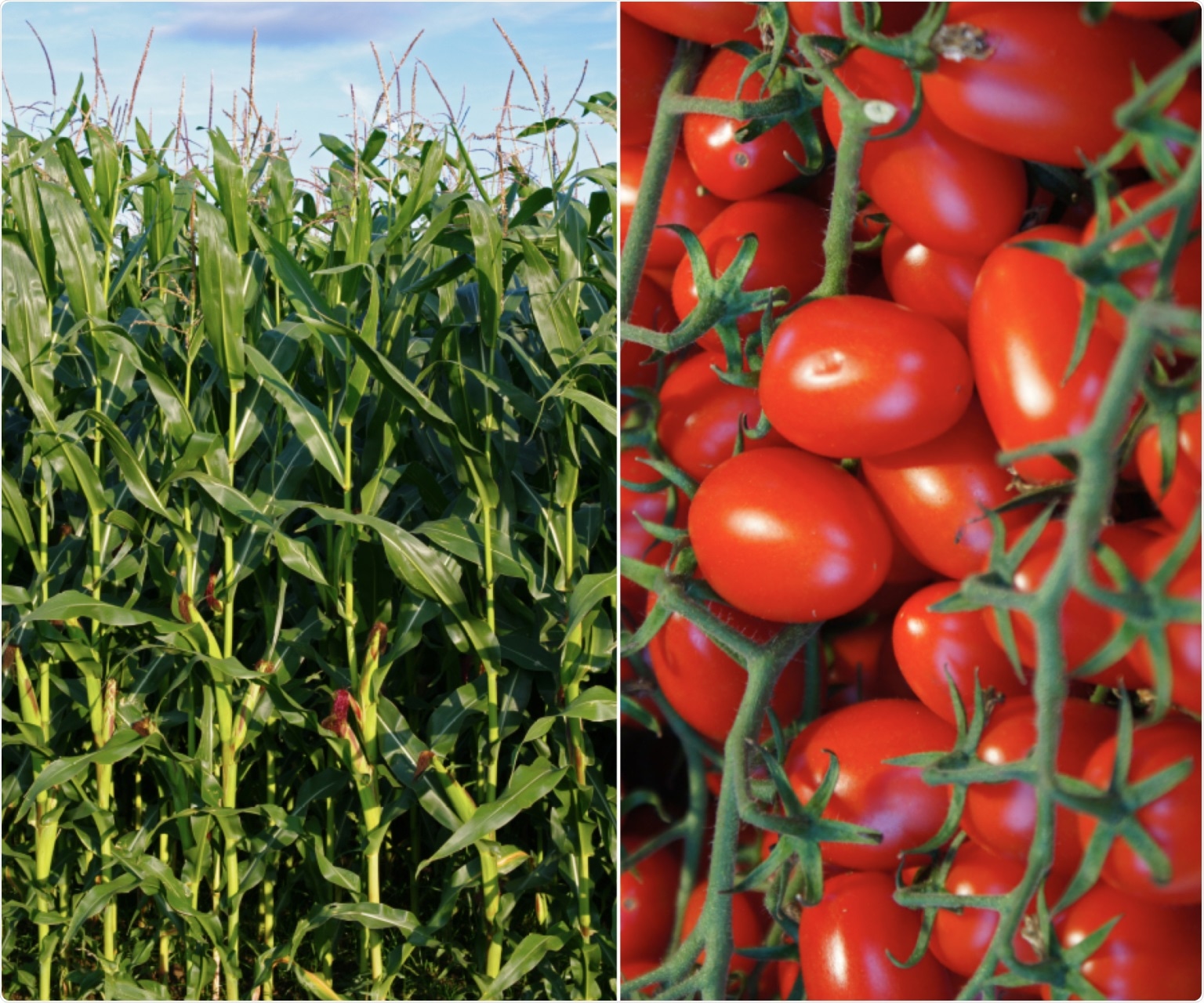To facilitate the demarcation between genetically modified organisms and genome-edited organisms, researchers at Hokkaido University have developed a framework that takes into account both scientific and socio-ethical considerations.

Maize (left) and tomatoes (right) have been subjected to genetic recombination to obtain desired traits. Genetically modified maize is cultivated at a large scale in many countries; the most common varieties have pest- and herbicide resistance. Genome-edited tomatoes have recently become commercially available in Japan; the variety contains high concentrations of γ-aminobutyric acid (GABA), a dietary supplement. Image Credit: Maize: CC by SA Christian Fischer; tomatoes: CC by Domdomegg.
Plants and animals have been bred for centuries to achieve desired traits, including higher yields, better flavors and tastes, and disease resistance. As DNA manipulation techniques advanced in the 1970s, genetic recombination between species became possible. Plants and animals that contain genes from other species are derived from genetic recombination, which is employed in the creation of genetically modified organisms (GMOs).
In recent years, genome-edited organisms (GEOs) have also been developed, in which the genome is more directly altered to produce desired traits.
Scientists Megumi Ishii and Tetsuya Ishii from Hokkaido University have developed a detailed framework for recognizing agricultural GMOs from agricultural GEOs, offering ethical, scientific, and social considerations. The study was published in the journal Trends in Biotechnology.
When DNA from one species is introduced into another unrelated species (exogenous DNA), there are ethical concerns, including risks to human health and the environment. Due to this, most countries have passed laws regulating the use of GMOs. Several countries, excluding Japan, have commercially grown GM crops for food; however, not many GM animals are approved for consumption worldwide.
The creation of GEOs using genome-editing techniques, like CRISPR/Cas9, requires the use of DNA-cutting enzymes within the cells. The majority of GE plants and animals do not contain exogenous DNA and, thus, are not typically subject to ethical concerns about exogenous DNA. A few countries consider GEOs as GMOs from a legal standpoint.
Some countries, such as Colombia, Argentina, Chile, Brazil, Australia, Japan, and the USA, have regulations in place that distinguish between the two, based on the presence of exogenous DNA. These regulators, however, analyze each case for the presence of exogenous DNA on an individual basis. If non-targeted exogenous DNA is present in any part of the process, genome editing could unintentionally cause genetic recombination.
To make a better distinction between GEO and GMO, the authors provided a detailed framework that includes scientific, ethical, and social considerations. Even in countries where there is already a legal distinction between the two, this framework will ensure that the reliability of the relevant regulation is enhanced.
Depending on the method used to create them, GEOs may contain exogenous DNA that could be incorporated into the organism. The resulting GEO can, therefore, be considered different from a GMO if there is no exogenous DNA introduced during the process.
If the reagents or culture medium contains exogenous DNA, the resultant GEO must be thoroughly screened for exogenous DNA in the genome. This can be accomplished by first identifying regions of the genome where exogenous DNA is most likely to be incorporated.
Multiple complementary techniques, such as target DNA sequencing, whole-genome sequencing, and genomic Southern blots, are subsequently used to examine those regions. If exogenous DNA is discovered, the GEO is classified as a GMO.
According to the researchers, the suggested framework also calls for ethical and societal considerations before laws exempting GEOs from GMO regulation are extensively implemented. A cost-benefit analysis weighs the possible benefits of adopting a genetically modified crop or animal against the risks of humans, the environment, and animal welfare.
Regulatory bodies may use a simple test to detect exogenous DNA, based on the circumstances. The final regulatory decision, on the other hand, must be taken after thorough public engagement and societal consensus.
Source:
Journal reference:
Ishii, M. & Ishii, T. (2021) Proving that a genome-edited organism is not GMO. Trends in Biotechnology. doi.org/10.1016/j.tibtech.2021.11.001.